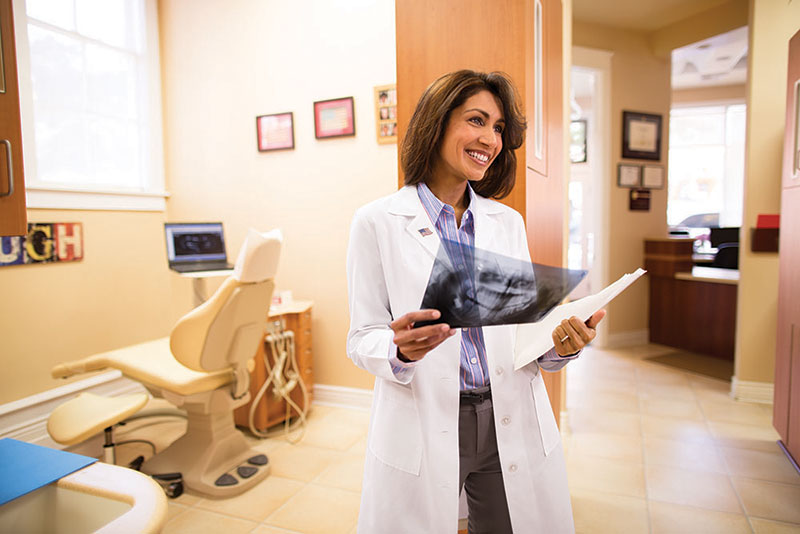
Workplace Safety in Dental Offices

Like all businesses, dental and orthodontia practices are required by the Occupational Safety and Health Administration (OSHA) to promote safe and healthy working conditions.[1]
While there are currently no specific OSHA standards for the dental industry, there are numerous biological, chemical, physical and environmental risks in dental practices that are subject to OSHA requirements. In particular, dental practice owners need to be aware of special OSHA safety standards[2] that pertain to radiation and bloodborne pathogens, as well as cuts, punctures and lacerations.
Here are three common risks affecting dental staff safety:
- Sharps injuries.[3] Among the most common risks affecting workplace safety in dental offices are sharps injuries. A syringe puncture can potentially expose dentists and hygienists to hazardous pathogens, which is why OSHA’s Bloodborne Pathogens Standard is one of the most frequently requested and referenced standards for dental offices. Its requirements include:[4]
- A written exposure control plan to be updated every year
- Providing employee safety training specific to handling bloodborne pathogens
- The use of universal precautions, an approach to infection control to treat all human blood and certain bodily fluids as if they were known to contain HIV, HBV or other bloodborne pathogens[5]
- Providing employees with appropriate personal protective equipment (PPE), such as gloves, masks, glasses and gowns
- Providing exposed employees with a free Hepatitis B vaccine as well as any necessary medical follow up
- Using proper sharps disposal boxes and containers for regulated waste and contaminated laundry
- Radiation exposure. Dentists and orthodontists use X-rays to help diagnose damage or disease that is not visible during a standard exam. Although radiation exposure associated with dentistry is minor, it is still important to take appropriate precautions to protect employees from unnecessary exposure. State laws and regulations set specific requirements for using X-ray machines.[6]
- Hazardous materials. Often referred to as the “employee right-to-know” standard, OSHA’s hazard communications regulation requires employers to inform workers what hazards are present in the workplace and how they can keep themselves safe.[7] As part of their jobs, dental professionals may come in contact with hazardous chemicals, such as disinfectants and anesthetics. To keep staff safe, employers must:
- Provide employees with information and training on the hazardous chemicals present in their work area, using language and vocabulary that employees understand
- Maintain an accurate list of hazardous chemicals in the workplace
- Label chemical containers and clearly identify the material inside
- Provide workers with Safety Data Sheets (SDSs) for each substance, which detail information about chemical hazards, side effects, exposure prevention and emergency treatment procedures. Chemical manufacturers must provide SDSs to employers.
By proactively addressing potential risks in their offices and prioritizing dental staff safety, dentists and orthodontists can reduce the possibility of workplace injuries and illnesses. For more information on creating a safe dental practice, contact EMPLOYERS .[8]
[1] The Occupational Safety and Health Administration, OSH Act of 1970, https://www.osha.gov/pls/oshaweb/owadisp.show_document?p_table=OSHACT&p_id=3355.
[2] The Occupational Safety and Health Administration, Dentistry, https://www.osha.gov/SLTC/dentistry/standards.html.
[3] The U.S. National Library of Medicine National Institutes of Health, Sharps injuries in dental practices, https://www.ncbi.nlm.nih.gov/pubmed/9526266.
[4] The Occupational Safety and Health Administration, Medical & Dental Offices: A Guide to Compliance with OSHA Standards, https://www.osha.gov/Publications/OSHA3187/osha3187.html.
[5] The Occupational Safety and Health Administration, Healthcare Wide Hazards, (Lack of) Universal Precautions, https://www.osha.gov/SLTC/etools/hospital/hazards/univprec/univ.html.
[6] Conference of Radiation Control Program Directors, Inc., Map of State Radiation Control Programs in U.S., http://www.crcpd.org/mpage/Map.
[7] The Occupational Safety and Health Administration, Workers’ Rights, https://www.osha.gov/Publications/osha3021.pdf.
[8] EMPLOYERS, www.employers.com.
Contact the professional at G & H Financial Insurance for your dental business insurance at 281-395-5497.
